![]()
![]()
![]()
Use LEFT and RIGHT arrow keys to navigate between flashcards;
Use UP and DOWN arrow keys to flip the card;
H to show hint;
A reads text to speech;
90 Cards in this Set
- Front
- Back
|
skin is what % of a dog's body weight? |
12%
|
|
|
epidermis is derived from what embryonic tissue type?
|
ectoderm
|
|
|
the dermis is derived from what embryonic tissue type?
|
mesenchymal
|
|
|
what are the 3 major layers of the epidermis
|
stratum cylindricum
stratum spinosum stratum corneum |
|
|
the stratum cylindricum and stratum spinosum collectively are known as what?
|
stratum germinativum
|
|
|
what percent of dermal fibers in the dermis are composed of collagen?
|
90%
|
|
|
the 2 indistinct layers of the dermis are the:
|
superficial stratum papillare
deep stratum reticulare |
|
|
the stratum papillare has what type of fibers? |
papillare: fine elastic and reticular fibers
reticulare: dense collagen bundles |
|
|
what does the adnexa of skin include?
|
hair follicles
sweat glands sebaceous glands all are of ectodermal origin |
|
|
Errector pilli muscles are innervated by?
|
autonomic nervous system
|
|
|
hair follicle pigmentation granules come in what 3 colors?
|
brown, black, yellow
|
|
|
Anal sac is lined with what cell type?s
|
stratified squamous epithelium
|
|
|
define apocrine
|
the secreted product is concentrated at the free end and is release with a small amount of cytoplasm
|
|
|
define holocrine
|
the entire secreting cell is release as part of the secreted product
|
|
|
define neurocrine
|
the secreting cell remains intact through the dormation and secretion of the product
|
|
|
the panniculus musculature is composed of which muscles?
|
platysma |
|
|
in the cat, the platysma is subdivided in the cervical region into what 2 muscles, and along what line?
|
supercervicocutaneous muscle and
cervicofacial muscle divided along the line of attachment to the skin |
|
|
what are the 3 levels of the cutaneous vascular system?
|
the deep, subdermal, or subcutaneous plexus
the middle, or cutaneous plexus the superficial or subpapillary plexus |
|
|
which of the 3 plexuses is the major vascular network to the underlying skin?
|
the deep, subdermal, or papillary plexus
|
|
|
why does canine skin generally not blister with superficial burns?
|
because their capillary loop system andpapillary bdies of their vascular system are poorly developed
|
|
|
where should skin be undermined to avoid cutting off its vital blood supply?
|
In the fascial plane beneath the cutaneous musculature to preserve the subdermal plexus
HOWEVER, if the area is devoid of musculature, one should undermine in the fascial plane well below the dermal surface |
|
|
tissue expanders, presuturing, and skin stretchers all take advantage of what phenomenon
|
mechanical creep
|
|
|
clinical features of cutaneous asthenia are
|
increased skin fragility
hyperelasticity laxity |
|
|
2 layers of skin? and beneath that
|
epidermis
dermis and hypodermis beneath composed of fat and CT |
|
|
differences in skin blood supply between dogs and cats
|
dogs: greater density of collateral sq vessels
cats: smaller number and wider distribution of cutaneous perforators |
|
|
another term for primary wound healing
|
first intention healing
healing of sutured wound (def) |
|
|
2 other terms for delayed primary closure?
definition? |
secondary closure |
|
|
second intention healing
|
heals without suturing
|
|
|
how do healing rates doffer between primary and secondary healing?
|
same, except with primary the area is smaller
|
|
|
rate of epithilialization? |
1mm/day
no |
|
|
tensile strength of a 5mm wide strip normal canine skin?
|
9.9kg
|
|
|
how strong is wounded skin in comparison to normal skin? |
5-10% as strong at 14d post sx
25% as strong at 3-4 weeks 70-80% at several months 80% at 1 year |
|
|
strength of sutured wounds in cats compared to dogs?
|
one stuy wounds were only half as strong as in dogs at 7d post op |
|
|
what is false healing?
|
in cats, where wounds appear healed and then dehisce after suture removal |
|
|
cats vs dogs, vascularity and wound strength
|
cats lowere perfusion first week post op followed by more rapid gain during second week.
by 2 weeks perfusion was the same
cats have more problems with healing. may ant to leave sutures in longer than 2 weeks |
|
|
effect of SQ removal on wound healing?
|
in one study all tissues deep to panniculus but superficial to thoracodorsal muscle fascia was removed, no effect on skin healing.
|
|
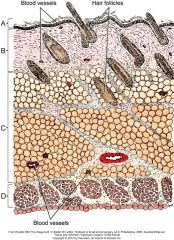
|
A. Epidermis
B. Dermis C. Hypodermis D. Cutaneous Trunci |
|

describe differences between canine and human blood supply |
major cutaneous vessels in dogs are parallel to skin whereas in humans they are perpendicular
|
|
|
healing of primary wounds influenced by what factors? |
tension
pressure motion self-mutilation patient health |
|
|
skin wounds usually closed parallel to lines of tension except where |
in limbs they may need to be closed perpendicular
|
|
|
patient factors that significantly effect wound healing include:
|
uremia
steroid admin hyperadrenocorticism geriatric status malnutrition |
|
|
how does geriatric status affect wound healing?
|
decreased cutaneous perfusion
increased skin fragility increased risk of infection |
|
|
how does malnutrition effect wound healing?
|
decreased albumin and hemoglobin levels |
|
|
what did they find in a study comparing monocryl with vicryl for intradermal sutures
|
vicryl group had more early swelling and redness, but there was no difference between the two groups later
|
|
|
name 2 important amino acids for wound healing
|
cysteine
methionone also, glutamine, arginine, zinc, fatty acids vitamin E |
|
|
name 2 advantages of eltrocautery for incisions
|
hemostasis
lymphatic sealing |
|
|
what is knot security of surgeons vs square
how many throws are necessary for different suture types for secure knot at START of continuous line? |
surgeons and square had same security
polyglycolic acid: 3 polyglactin 910: 3 polypropylene: 3 chromic gut: 4 PDS: 5 nylon: 5 |
|
|
whic considered better for small animal incisions: cautery or sharp and why?
wound strength between the two? |
sharp
cautery (if used improperly)can cause thermal damage to wound that affects cutaneous perfusion and delays healing sharp incisions had twice the wound strength as those made with cautery at 7-10d post op scalpel incision had less drainage and faster/stronger healing |
|
|
when skin is incised by radiowaves, CO2 laser, monopolar electrocautery, how far will char extend?
|
radiowaves: 0.171mm
Co2: 0.215 monopolar:0.255 |
|
|
one way of hemostasis with small vessels
|
if less than 1mm, ,can grasp with hemostats and twist 360 degrees multiple times.= to a ligature in small vessels |
|
|
when is the "golden period"?
|
up to 3-6 hours after wound initiation. within this time bacteria can mutliple to 10^5 per gram of tissue or mm of exudate
|
|
|
how long does it take for degree of tissue necrosis to be established in crushing wounds?
|
3-7days
|
|
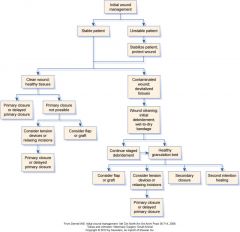
|
describe steps
|
|
|
how many throws are necessary for different suture types for secure knot at END of continuous line?
|
polyglycolic acid: 5
polypropylene: 5 chromic gut: 5 polyglactin 910: 6 nylon: 6 PDS:7 |
|
|
aberdeen compared to square
|
equally secure
|
|
|
does tight SQ closure compromise skin vascular supply
|
not proven
|
|
|
study looking at SQ vs no SQ layer closure in cats?
|
no difference grossly, microscopically less seroma in those with SQ layer closed
|
|
|
what was foudn in dog study looking at monocryl for intradermal closure vs monocryl or prolene skin sutures?
|
intradermal group had more initial post op swelling and redness but fewer complciations overal by 10-14d
use of absorbably monocryl for skin sutures was associated with more incisional swelling and discharge at 14d post op |
|
|
what did they find in study looking at wound birsting strength with sutures placed 3, 6, or 10mm from linea alba in rats?
|
immediately: sutures placed 10mm away had higher bursting strength
at 4d sutures placed 3 or 6mm (and at closer intervals) had higher bursting strength |
|
|
study looking at spays closed with intradermal monocryl vs cutaneous sutures found what?
|
more inflammtion 18-24 hours post in intradermal group, less inflammation at 10-14d
also, intradermal assctd with less pain in women |
|
|
what is the tucking maneuver?
|
smurfing
|
|
|
tissue adhesives vs. skin sutures?
|
one study which created random pattern skin flaps in dogs found that wounds closed with skin sutures vs glue and few skin sutures had equal tensile strength |
|
|
fibrin sealants
|
human and bovine have been studied.
do not increase wound breaking strength over sutures alone only used experimentally |
|
|
how long does it take dog ears to regress in human studies?
|
ears less than 8mm regress completely by 132 days |
|
|
how do lidocaine and bupivicaine work?
|
bind to neuronal membrane receptors, inhibiting Na ion influx. membranes become less stable, which inhibits initiation of action potential and conduction of nerve impulses, preventing pain sensation |
|

what is a step defect and what is the consequence |
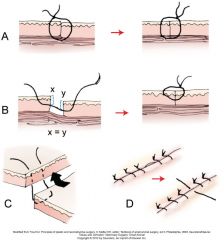
when wound edges are not opposed in level fashion
image on front of slide is demonstrating dog ear, with apex cutaneous suture used to correct it |
|
|
triple ab over primarily closed wounds
|
provide moisture
may enhance epithelialization |
|
|
do NSAIDS effect wound healing?
|
theoretically should but studies have shown no effect |
|
|
what happens with application of 5% lidocaine patches to wounds in humans
|
blocks pain, but can still feel pressure, touch, temperature
|
|
|
pharmacokinetics of 5% lidocaine patches applied to normal skin in dogs?
|
systemic absorption by 12 hours, |
|
|
local block before or after skin incision?
affect on wound healing? |
before. one study showed that when blocked before skin incision was made dogs had lower post-op pain scores and required less opiod that when blocked after skin incision
analgesic effect seemed to last for 24hours (longer than expected based on halflife) no deleterious effects on wound healing in this study |
|
|
how deep do cold packs penetrate?how long should they be left on and why? |
all the way to periosteum
not longer than 20min to avoid injury or delayed wound healing from vasoconstriction |
|
|
wounds that are perfectly apposed can have an epithelial seal within ___ hours? |
24 |
|
|
under what circumstances would you consider closing a traumatic wound primarily? |
if occurred within 3-6 hours, wound edges fresh and vascularized no evidence or history of crushing injury no visible contamination or debris after wound contamination
|
|
|
what do they call the loop at the end of the suture line? |
penultimate loop |
|
|
how long should suture tags be? |
3-4mm for buried knots |
|
|
what needle type is recommended for sq closure? |
1/2 or 3/8 circle taper |
|
|
does a continuous SQ layer compromis blood supply more than an interrupted layer? |
some think so, but no evidence |
|
|
where should tacking sutures be avoided? |
in areas where skin moves freely(over thorax) |
|
|
how big should bites in SQ be? |
0.5-1cm |
|
|
how are intradermal and subcuticular different? |
they are the same |
|
|
what are the 2 different types of intradermal closure? |
vertical: bites placed perpindicular to skin edge, incorporate sq
horizontal, along skin edge, just dermis |
|
|
needle type for skin sutures? |
usually 3/8 circle on cutting |
|
|
does horizontal mattress sutures result in inverting/everting/apposition? |
any, depending on how they are placed |
|
|
does vertical mattress result in apposition, inverting or everting |
everting or apposition |
|
|
what is a benefit to ford interlocking? |
same fetures as continuous, but if line breaks, the locking may keep incision opposed partly |
|
|
which is stronger in tissues under tension, horizontal or vertical mattress? |
vertical |
|
|
how are bites taken for a vertical mattress intradermal pattern? |
from deep to superficial on near side, and from superficial to deep on far side
benefit is that you are unlikely to compromised blood supply-because suture is parallel to cutaneous perforator vessels |
|
|
describe these ways to correct a dog a dog ear |
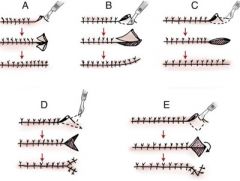
A:removal of small triangles B: removal of one large triangle C: removal of ellipse D: removl of arrowhead E. half z correction |
|
|
what are some ways to correct crescent shaped defects? |
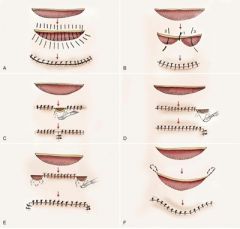
|

